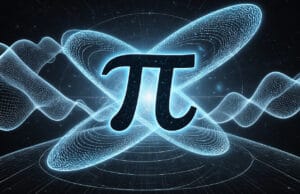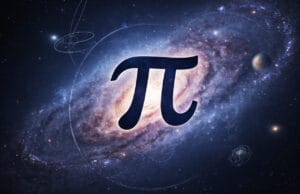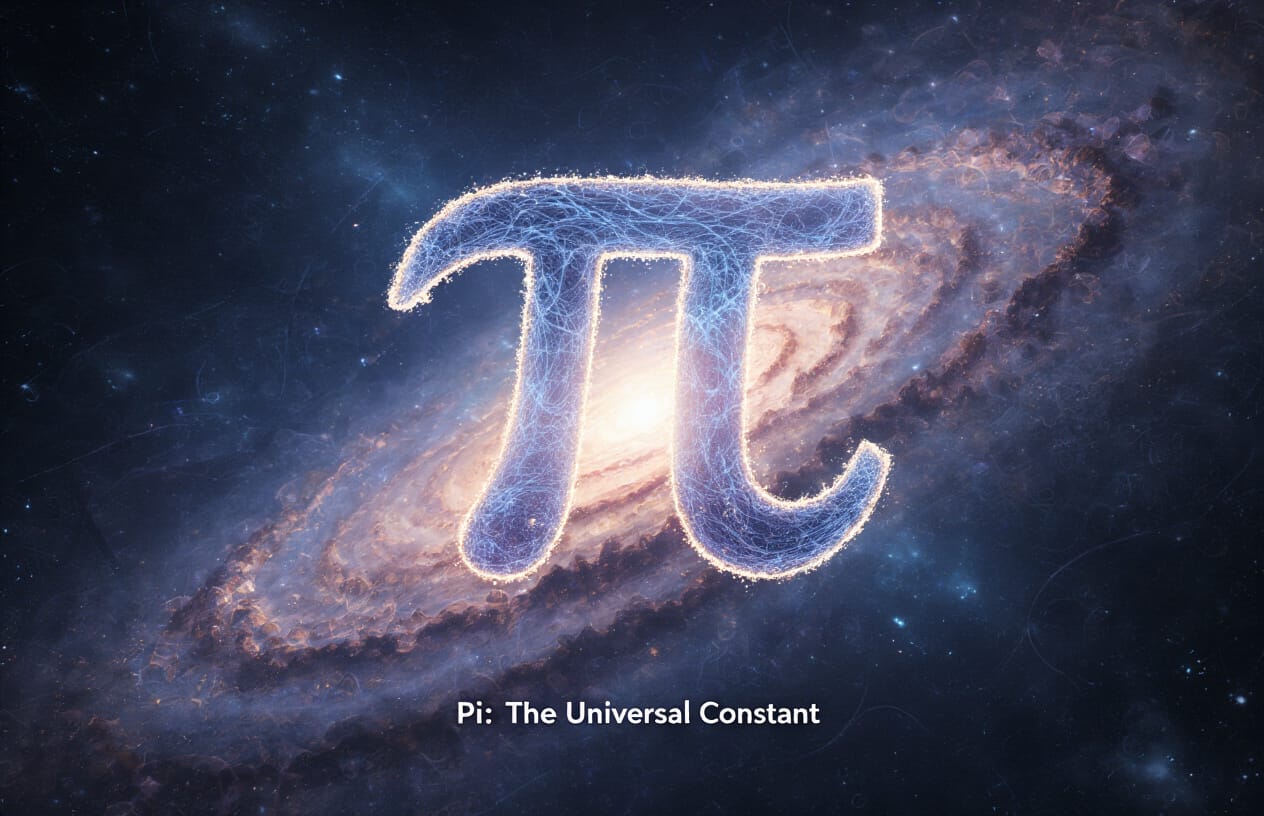How Pi Shapes Our Universe: From Atoms to Galaxies
Ever wonder why physicists get that starry-eyed look when they mention pi? It’s not just math-nerd nostalgia. This seemingly simple 3.14159… is practically running the universe behind the scenes.
From the perfect circles of planetary orbits to the invisible waves that carry your favorite songs through the air, pi shapes our mathematical universe in ways that would blow Archimedes’ sandals off.

I’ve spent years explaining complex mathematical concepts to people who “just don’t do math,” and trust me—understanding pi’s role in the cosmos doesn’t require differential equations or a PhD.
The mathematical patterns of pi appear everywhere in nature, from the spiral arrangement of seeds in a sunflower to the mysterious dance of subatomic particles. But here’s what keeps me up at night: what if pi isn’t just describing our universe… but creating it?
The Mathematical Identity of Pi
Defining Pi: More Than Just 3.14159…
Pi shapes isn’t just some random number we memorize in school. It’s the key that unlocks countless doors in mathematics. When we measure a circle’s circumference divided by its diameter, we always get this mysterious value that never ends and never repeats.
The Transcendental Nature of Pi
Pi refuses to be pinned down as a fraction or as the root of any polynomial equation with rational coefficients. This stubborn quality, called transcendence, is what makes pi so special. It’s not just weird math trivia—this property explains why pi shows up everywhere from quantum physics to spiral galaxies. How Pi Governs Subatomic Particles
Pi doesn’t just hang out in geometry class—it’s actually calling the shots at the quantum level. When electrons orbit atomic nuclei, their positions follow wave patterns described by equations riddled with π. Not a coincidence!
Pi in Quantum Field Equations

Crack open any quantum physics textbook and π jumps out everywhere. The Schrödinger equation? Full of π. Quantum electrodynamics? More π. These tiny particles dance to π’s tune, whether they know it or not.
A. Circular Motion and Pi
Pi shapes isn’t just a math curiosity – it’s the heartbeat of everything that spins or rotates. Every wheel on your car, every planet’s orbit, even the whirl of your washing machine depends on pi. The distance around any circle is always pi times its diameter, which means pi controls how fast things spin and how they move in circles.
B. Waves, Oscillations, and Pi’s Influence
Sound waves, light waves, ocean waves – they all dance to pi’s tune. When you hear music or see colors, you’re experiencing pi in action. These waves follow sine and cosine patterns, which are pi’s fingerprints in the physical world. Engineers use these pi-based wave equations to design everything from speakers to cell phones.
Pi in Orbital Mechanics
Pi isn’t just some boring number from your high school math class. It’s actually the secret sauce behind how planets orbit stars. Every time Earth makes its yearly journey around the sun, pi is there, quietly determining the perfect elliptical path.
Einstein’s Field Equations and Pi
Ever wonder why Einstein was such a big deal? His field equations contain pi in crucial places. When gravity bends spacetime, pi helps calculate exactly how much bending happens. Without this magical number, we’d have no GPS systems or accurate predictions about cosmic events.
Patterns That Connect Micro and Macro Worlds
Pi shapes doesn’t play favorites with scale. It’s there in the atomic orbits of electrons and in the massive sweep of galactic arms. Crazy, right? This mathematical constant creates a hidden thread connecting the tiniest particles to cosmic structures billions of light-years across.
Pi in Natural Phenomena
Look around you. Pi shapes shows up in river bends, DNA spirals, and even how light waves spread. It’s not just some dusty number from math class—it’s the secret code running through everything from how seeds arrange in a sunflower to how hurricanes form their spiral patterns.
Throughout our journey from the subatomic world to the vast cosmic scales, we’ve seen how the seemingly simple number π weaves its way through reality. From quantum wave functions and Heisenberg’s uncertainty principle to the everyday physics of pendulums and sound waves, π is fundamental to understanding our physical world.
Perhaps most remarkably, this mathematical constant appears in Einstein’s field equations and helps describe the very shape and expansion of our universe.
The universal presence of π across vastly different scales highlights a profound truth about our reality—mathematics isn’t just a human invention but reflects the underlying structure of the universe itself.
Whether we’re studying elementary particles or distant galaxies, the same mathematical patterns emerge, connecting the infinitely small with the infinitely large. This mathematical harmony reminds us that despite the apparent complexity of our universe, elegant simplicity often lies at its core.
Why is 22/7 used as an approximation for PiUREMENT See the factorization of the denominator in 22.7 5.8 k0.2 3.4.
Getting to know Pi and the mysterious history behind it

For hundreds of years, mathematicians and scientists have been obsessed with an irrational, transcendental number known as Pi. Commonly referred to as the Greek letter π (pronounced “pi”), it is estimated as the ratio of a circle’s circumference to its diameter. The structure and complexity of this j has motivated countless researchers. Central to a lot of their computations is a well-known fraction: 22/7. This is what has given us the popular term: “Pi shapes math 22/7”.
The term “Pi math 22/7” is a mathematical shortcut found all around education, engineering, architecture and even in astronomy. But what exactly is Pi? Why do we talk about 22/7 so much? And is it accurate? This detailed article seems to cover all the important details related to the concept of Pi and its relation to 22/7.
The Definition And Definition Of Pi
What is Pi?
Pi is the relation of the circumference of any circle to its diameter. That means:
π = Circumference ÷ Diameter
This is true for all perfect circles irrespective of size. The result? An irrational number that starts 3.14159 and goes on forever without repeating. Yet because the measurement process is so complicated, precise calculations often become approximations. That’s where “Pi shape math 22/7” comes in.
The Irrationality of Pi
In math, something that can’t be represented as a nice, round, simple fraction is generally referred to as “irrational.” This is where Pi stands out. The number Pi shape is the circumference of a circle divided by its diameter, and no matter how far you take it in decimal places, it will never end or have a repetition. Unlimited Pi shapes has been calculated to trillions of places and the sequence just never settles down into a pattern. This complexity is what makes scrapings like Pi math 22/7 valuable.
Development 22/7 as an Approximation
Who First Used 22/7?
The concept of approximating Pi shapes is thousands of years old. Early Egyptian and Babylonian mathematicians employed approximate values, such as 3.125 or 3.1605. But it was Archimedes, a Greek mathematician of the 3rd century BC, who gave us the most well known approximation of pi, 22/7.
Archimedes’ Contribution
Archimedes derived Pi shapes by polygon outside (and inside) circles and measuring their perimeters. He demonstrated by this geometric method that:
223/71 < π < 22/7
The result of this calculation,, led to for 22/7 as the best rational approximation of Pi and hence the basis of the use of “Pi math 22/7”.
What is Haunting 22/7 Most in Schools?
Simplicity in Teaching

Rational numbers are employed for mathematical operations at the school level, and using irrational numbers such as Pi shapes may complicate the calculations for no good purpose. Instead, teachers rely on “Pi math 22/7” to make it easier to learn. The fraction 22/7 is easy to remember, and is close enough for most classroom work.
Proximity to true value of assertion
Pi is not 22/7 Your a little off 22/7 is 3.14285716 (also not a fraction), and the true value of Pi in decimals form starts off 3.1415926535… This makes “Pi math 22/7” accurate to within two decimal places, which is often enough for most educational and practical uses.
Accuracy of Pi math 22/7
You see, “Pi math 22/7”, this is an excellent approximation almost for all purposes.
Where it Fails
In precision-based sciences such as quantum physics or aerospace engineering, the value of 22/7 for Pi isn’t adequate. Here you need the Pi shapes values (to a lot of decimals) to have no errors.
Practical Applications Of Pi math 22/7
Geometry and Construction
Circle and arc calculations are commonly encountered by builders and architects. “Pi math 22/7” speeds up the math, but does not compromise an acceptable level of accuracy.
Engineering and Manufacturing
In the mechanical world, anything with gears and wheels usually means circular motion. Here too, Pi shapes is essential. “Pi math 22/7” is often trotted out by engineers for ballpark figures.
Astronomy
In classic astronomy, “Pi math 22/7” is used for determining sizes of celestial bodies and planetary orbits.
Computer Science
Though computer algorithms now produce much more accurate values of Pi shapes , some simpler programming for basic graphics and geometry still includes “Pi math 22/7” in certain educational tools.
Advanced Approximations Beyond 22/7
Other Rational Approximations
Other fractions than 22/7 provide even higher precision:
355/113 (alleged by Chinese mathematician Zu Chongzhi)
103993/33102 (highly accurate but complex)
Despite the above pi math 22/7 is still a favourite for simplicity.
Use in Programming
Today, modern programming language such as Python and JavaScript have built-in constants Pi that are accurate to at least 15 decimal points. Still, grasping Pi in math 22/7 can prepare you for more advanced calculations.
Pi day inspired by 22/7

Pi Day (14th March) Pineapple day (July 22) – 22/Pi (usually 0.07).
Pi Day (3/14) marks Pi in terms of its decimal value.
22 July (22/7) is called Pi Approximation Day and celebrates the use of Pi in maths 22/7.
Cultural and Educational Events
It is a day when schools may teach students about circles, geometry, and about the interesting number that is pi shapes . Activities typically involve solving puzzles based on Pi shapes math 22/7 and learning about Archimedes.
The future of (π) and its approximations
Will 22/7 Ever Be Obsolete?
It is easier to obtain ever more accurate approximations of Pi shapes with technology now. However for education and daily work, it doesn’t matter. We can keep using Pi value 22/7 because of its simplicity and ease of use.
Encouraging Deeper Learning
Although 22/7 is a good introduction, teachers should now be encouraging first-hand engagement by students with the difference between something they can calculate and Pi shapes , irrational numbers, series approximations (like the Leibniz or Nilakantha) and state-of-the-art computational methods.
FAQs on Pi math 22/7
Q1 Is Pi really equal to 22/7?
No Pi is irrational 22/7 is rational. They are nearby but they are not equal.
Q2 Then why do we use 22/7?
Because it’s convenient, mnemonic and good enough for a vast number of applications.
Q3.Can I use 3.14, for 22/7?
Yes. Both are approximations. 3.14 is a decimal; 22/7 is a fraction. Choose based on your needs.
Q4 What makes Pi so special?
Pi shapes comes up in a wide range of mathematical, scientific and engineering problems. It’s everywhere a circle exists!
Conclusion: Embracing Pi with Purpose
The tale of Pi shapes is endless, just like its decimal representation. From the dusty papyrus of ancient Greece to your weekend homework, “Pi math 22/7” has stood as bridging object between what’s irrational, and what’s understandable. It’s not perfect, but it has the advantage of being practical, and steady and standard throughout high school math and the applied fields.
Grasping “Pi math 22/7” gains you not only a number, but a view of humanity’s struggle to know the universe with precision, curiosity and creativity.

